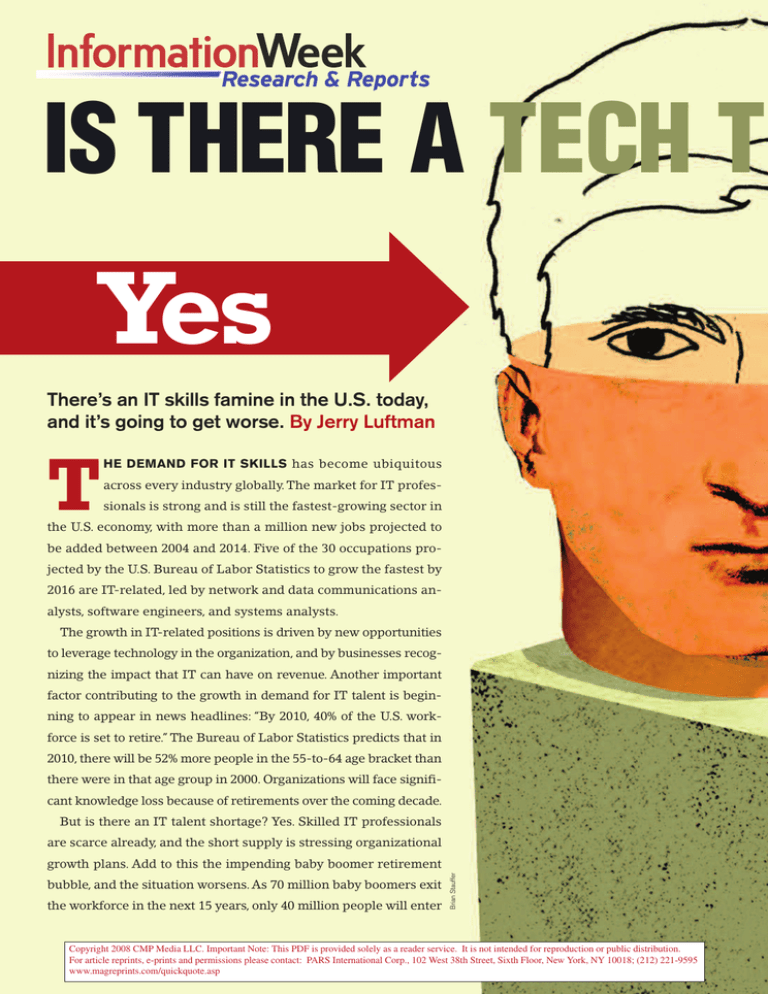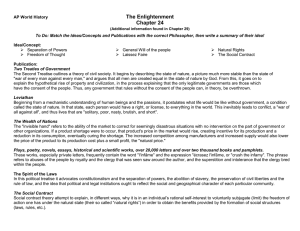Yes IS THERE A S TECH TALENT
advertisement

IS THERE A TECH T Yes There’s an IT skills famine in the U.S. today, and it’s going to get worse. By Jerry Luftman T HE DEMAND FOR IT SKILLS has become ubiquitous across every industry globally. The market for IT professionals is strong and is still the fastest-growing sector in the U.S. economy, with more than a million new jobs projected to be added between 2004 and 2014. Five of the 30 occupations projected by the U.S. Bureau of Labor Statistics to grow the fastest by 2016 are IT-related, led by network and data communications analysts, software engineers, and systems analysts. The growth in IT-related positions is driven by new opportunities to leverage technology in the organization, and by businesses recognizing the impact that IT can have on revenue. Another important factor contributing to the growth in demand for IT talent is beginning to appear in news headlines: “By 2010, 40% of the U.S. workforce is set to retire.” The Bureau of Labor Statistics predicts that in 2010, there will be 52% more people in the 55-to-64 age bracket than there were in that age group in 2000. Organizations will face significant knowledge loss because of retirements over the coming decade. But is there an IT talent shortage? Yes. Skilled IT professionals are scarce already, and the short supply is stressing organizational bubble, and the situation worsens. As 70 million baby boomers exit the workforce in the next 15 years, only 40 million people will enter Brian Stauffer growth plans. Add to this the impending baby boomer retirement Copyright 2008 CMP Media LLC. Important Note: This PDF is provided solely as a reader service. It is not intended for reproduction or public distribution. For article reprints, e-prints and permissions please contact: PARS International Corp., 102 West 38th Street, Sixth Floor, New York, NY 10018; (212) 221-9595 www.magreprints.com/quickquote.asp ALENT SHORTAGE? No Employers game the system and misrepresent the key market indicators. By Ron Hira E MPLOYERS CLAIM THERE IS a severe shortage of IT workers in the United States. Listen in on any klatch of CIOs, and the conversation inevitably turns to their diffi- culties finding talent. Microsoft’s Bill Gates, Intel’s Craig Barrett, and other captains of tech industry argue that the situation has reached crisis proportions. But moving beyond anecdotal impressions and vested interests, the employment and economic data paint another picture—one in which the IT labor market is clearing and none of the indicators demonstrates a systemic shortage. While exceptional talent or skills in emerging technologies will always, by definition, be in short supply, the most relevant market indicators—wages and employee risk—clearly show there’s no broad-based scarcity of U.S. IT workers. In their zeal to enlist government help to expand the supply of tech workers through foreign guest worker programs, employers are misrepresenting IT labor market conditions. A key indicator of tightness in any labor market is wages—more specifically, whether wages are rising much faster than the norm. IT worker wages grew by a modest 2.9% in constant dollar terms from 2003 to 2005, according to Department of Labor data compiled by the Commission on Professionals in Science & Technology (CPST). This increase is indeed greater than the average 0.6% Copyright 2008 CMP Media LLC. Important Note: This PDF is provided solely as a reader service. It is not intended for reproduction or public distribution. For article reprints, e-prints and permissions please contact: PARS International Corp., 102 West 38th Street, Sixth Floor, New York, NY 10018; (212) 221-9595 37 Jan. 7/14, 2008 www.magreprints.com/quickquote.asp Yes the workforce. McKinsey & Co. predicts that over the next three decades the demand for experienced IT professionals between the ages of 35 and 45 will increase by 25%, while the supply will decrease by 15%. U.S. IT executives have reported their concerns about the talent shortage of qualified American job seekers, and they have been largely ignored. As far back as 1998, the Society for Information Management (SIM) stated that educational institutions, organizations, and government must “take decisive action now” to address the shortage of skilled IT pros. Nine years down the road, IT leaders still report that their greatest challenge is recruiting the right IT people and then developing and retaining them. In a 2007 SIM survey of 130 senior IT execs, 51% cited “attract, develop, and retain IT professionals” as a top concern, more than any other factor. Americans don’t appear to be rushing to gain the ITrelated skills that organizations are —Jerry Luftman, looking for. The Stevens Institute of Technology, National Center for Society for Information Management Education finds that only 13% of graduate degrees awarded in the United States are science degrees. Undergraduate enrollments in computer science between 2001 and 2006 dropped 40%. Educators in K-12 school systems have reported declines in math and science competence in their graduates. Close to a third of all teenagers drop out before they graduate from high school. Public school teachers and counselors are unable to communicate the opportunities available in IT. Parents aren’t encouraging children to get into the IT field because of the dot-com failures and inaccurate media reports about all IT-related jobs going to India. Children are left disinclined to pursue an IT career. Nearly 70% of middle school teachers lack education and certification in mathematics, let alone computer and business skills, the National Center for Education finds. Some suggest that organizations should leverage the talent of foreign students being educated in the Students, parents, and counselors don’t recognize IT career potential. No growth for all professional occupations, but the gains for IT workers were hardly robust and don’t indicate any significant scarcity. More recently, we’ve seen some growth in the wages for newly minted bachelor’s degree computer scientists, according to the National Association for Colleges & Employers. Salaries for those entry-level jobs rose from $50,744 in 2006 to $53,051 in 2007, an increase of 4.5%. But those gains were almost completely gobbled up by inflation, which ran about 4.3% in 2007. Another factor in considering the relative health of the IT job market is the level of risk employees face. As any investor will tell you, riskier investments should have the higher potential payoffs. It’s no different with careers. While there are no formal measures of the risk and uncertainty of IT careers, it’s obvious that they have soared over the past few years. The train wreck of 20022004 in the IT la—Ron Hira, bor market deRochester Institute of Technology, railed the careers Economic Policy Institute of many professionals; some tech pros haven’t come back. Meantime, employer norms have shifted radically. Long gone are the days when IBM never laid off a worker. Nowadays, companies don’t think twice about shipping IT work overseas or bringing in lower-cost foreign workers to replace U.S. employees, and even asking American workers to train their replacements. Intel’s Barrett writes an op-ed piece about the shortage of U.S. workers even when his own company is in the process of major layoffs, shedding 14% of its workforce over the past two years. In addition, the risk of technological obsolescence and age discrimination are higher in IT relative to other professions. How many physicians or pharmacists become obsolete at age 40? Put in this context, it’s hard to believe that the very modest wage gains of the past few years balance the increases in IT employee risk. The consequences of this new equilibrium play out Modest wage gains don’t balance the rise in employee risk. Copyright 2008 CMP Media LLC. Important Note: This PDF is provided solely as a reader service. It is not intended for reproduction or public distribution. For article reprints, e-prints and permissions please contact: PARS International Corp., 102 West 38th Street, Sixth Floor, New York, NY 10018; (212) 221-9595 www.magreprints.com/quickquote.asp Yes Top-Paying Jobs For 2006 Grads $55,900 United States. However, that pipeline’s getting weaker, too. In 2007, American colleges and universities received 27% fewer graduate applications from international students than in 2003. F-1 visas issued to international students fell 10% between 2001 and 2005. All of these factors are contributing to a famine in IT-related skills in the U.S. marketplace. Also, because of quotas, U.S. organizations haven’t been able to bring skilled foreign IT professionals on temporary visas and green cards into the country. In a significant move, the European Union is pushing to provide “blue cards” aimed at attracting foreign-born IT pros to combat the shortage of tech talent in that region. If successfully implemented, the blue cards would apply in all 27 EU member states, increasing their economic competitiveness. OUTSOURCING ISN’T THE ANSWER The Society for Information Management, in its continuing concern about the IT workforce, recently sponsored a survey of top IT management to determine the skills and capabilities they want to hire and develop within their organizations, and what they would ob- Chemical engineering $54,877 Computer engineering $52,899 Electrical and communications engineering $50,672 Mechanical engineering $50,046 Computer science $45,732 Accounting Economics/finance Civil engineering $45,191 $44,999 $39,850 Business administration/management $36,260 Marketing/marketing management Data: National Association of Colleges and Employers 2005 Outlook Survey tain through service providers. The results indicate that while some IT skills in the purely technical areas (e.g., programming) will be obtained through sourcing Shortage? Not A Staff -Vs.-Bosses Question T HERE’S A RAW, EMOtional split in the IT community over whether there’s truly a U.S. shortage of tech talent. Some see the talent “shortage” as an idea cooked up by management to justify more visas for low-wage foreign workers. But our recent survey found something surprising: Business technology managers and staffers hold very similar views on whether there’s a shortage. About two-thirds of both groups see some signs of a shortage. The most prevalent view—by 45% of managers and 40% of staff—is that there’s a shortage only in certain IT specialties and some geographies. Another quarter of staffers and 29% of managers see a shortage in many IT areas, according to our survey of 893 managers and 270 staffers involved in the IT hiring process. Twenty-three percent of managers and 29% of staffers say there’s no U.S. shortage. The question becomes volatile in the context of offshore outsourcing and H-1B visas for foreign workers. Offshoring critics hear talk of a shortage— or even just healthy employment—and they fear IT vendors will use that as leverage to import more foreign workers into the United States. 2007 was indeed a very good year for IT job creation, according to the most recent numbers from the Bureau of Labor Statistics—the best year ever, in fact, in the seven years the bureau has been using its current IT job categories to survey workers. The eight IT job segments added more than 300,000 jobs last year, with average quarterly employment topping 3.76 million last year, up from 3.46 million at the end of 2006. Quarterly unemployment for those categories averaged 2% in 2007, exactly the same as for the larger professional and management employment category. Software engineers and computer scientists/system analysts make up 45% of the IT workforce. Still, IT pros remain unsure of the profession’s future. Just 55% of staffers who responded to our survey say they believe there are more career opportunities today than when they entered the profession, while 59% of managers think that’s the case. Sixty percent of staffers and 62% of managers believe the United States is losing its leadership position in IT. Yet a healthy majority would recommend an IT career to a child or other family member—74% of staffers and 71% of managers. One 16-year IT veteran, a director supporting engineering applications at a major electronics company, says IT’s not much different from most career choices—it depends on the company. A company that’s growing, adding new Copyright 2008 CMP Media LLC. Important Note: This PDF is provided solely as a reader service. It is not intended for reproduction or public distribution. For article reprints, e-prints and permissions please contact: PARS International Corp., 102 West 38th Street, Sixth Floor, New York, NY 10018; (212) 221-9595 www.magreprints.com/quickquote.asp No most prominently in career choices for those attending college. Enrollment of undergraduate computer science majors in major U.S. colleges and universities has plummeted an astounding 40% over the past four years, according to a survey by the Computing Research Association. Many blame a lack of interest in the tech field among young people, or our failing K-12 education system. But the most likely explanation is that students, using an array of information at their disposal, including advice from relatives in the field, have decided that IT isn’t as attractive an option as it once was. SHRINKING EXPECTATIONS More than any other indicator, student choice is an excellent pulse on the outlook for the U.S. IT labor market. The good news is that enrollments have stabilized, perhaps in reaction to the bottoming out of the tech recession. Even so, shrinking expectations of the size of the IT labor market are supported by the lackluster growth over the past few years, as well as by the future growth forecast by the Department of Labor. IT employment was slightly more Ithan 3 million in 2006, up 2.2% from 2004, but those gains lagged the overall U.S. employment growth of 3.7% over the same period, according to CPST. Meantime, the employment outlook continues to weaken. In 2000, the Bureau of Labor Statistics projected that the United States would have 4,894,000 IT jobs by 2010. Since then, the bureau has consistently ratcheted down its forecasts, with the most recent projecting 3,522,000 IT jobs in 2010. I don’t advocate using these forecasts as destiny, since the bureau has no way of accounting for important factors that will affect IT labor growth, whether it’s on the downside (offshoring) or upside (technological breakthroughs). But it’s one more important indicator of IT job market trends. The average unemployment rate for IT occupations in 2007 was 2%, according to Bureau of Labor Statistics numbers released earlier this month, the same rate as for professional occupations as a whole. This compares favorably with the record high unemployment rates for IT workers just a few years ago. In 2003 the unemployment rate in IT was 5.5%, compared with 3.2% for all professional occupations. We must take into account, however, that many of the IT workers laid off between 2002 and 2004, but Is There A Shortage Of IT Talent In The U.S. Today? we have an excuse to go offapplications, and building 29% Yes, in many 4% IT areas shore to fill the position.” new systems is going to proDon’t know U.S. IT workers are split vide an exciting track for a evenly over the coming baby young person starting a ca24% wave, with boomer retirement reer. One in belt-tightening, No, there’s managers slightly more wordo-more-with-less mode will no shortage ried than staff. Managers split make it tough. He sees a talexactly 50-50, while 42% of ent shortage in his specialstaff expect a shortage. Says ized area, supporting highly 43% Yes, but only one survey respondent: “Most technical engineering applicain certain specialized IT areas or geographies of the retiring baby boomers tions, because it’s hard to are not really ready to retire, find experienced people eiData: InformationWeek survey of 1,163 business technology so you will see about 40% of ther in the United States or professionals involved in the hiring process for IT professionals that workforce continue to abroad, and it’s not a growth “not even close.” Based on the number work well into their 70s ... at their office area that attracts entry-level people. It’s in their homes or in a nearby office.” of survey comments criticizing employer “more of a quality shortage than in acThere’s plenty of uncertainty heading training, we also should have asked tual head count,” he says. into 2008. Will healthy IT job growth conThe IT pros we surveyed give U.S. col- about that. A typical comment, from a tinue? If there’s an economic slowdown, business continuity manager: “I have leges faint praise for preparing students will IT be severely cut, as it was during with the right skill sets. Just 9% say they seen a reluctance of IT shops to train or cross-train applicants or staff to fill them. the last recession? One thing’s likely: IT do, 54% say they “mostly” do but are [The attitude of some companies is] if we pros are likely to remain sharply divided lacking in some areas, while 37% say can’t find the perfect fit employee, then over the answers. they’re either lacking in many areas or —CHRIS MURPHY Copyright 2008 CMP Media LLC. Important Note: This PDF is provided solely as a reader service. It is not intended for reproduction or public distribution. For article reprints, e-prints and permissions please contact: PARS International Corp., 102 West 38th Street, Sixth Floor, New York, NY 10018; (212) 221-9595 www.magreprints.com/quickquote.asp Yes No Continued from p. 40 from service providers, employers still have a strong need for IT professionals who have a combination of technical and business-related skills—such as business and industry knowledge and project management and communications skills. In addition, these IT executives expressed a concern that such individuals are in short supply. Overall, while very large organizations (more than $3 billion in revenue) and medium-sized organizations ($500 million to $3 billion) are both increasing the amount of work they send to service providers, companies with less than $500 million in revenue are increasing their in-house IT staffs more than increasing their outsourcing activities. Since such businesses make up 99% of U.S. businesses (according to the U.S. Small Business Administration in 2006), this is a significant source of jobs. What this research and other projects that have been carried out are saying is that the market for individuals with IT-related skills is growing. The growth is in IT organizations within client compa- Where The IT Jobs Are 5% Network and systems administrators 3% Database administrators 5% 25% Software Network and data communications analysts engineers 9% Support specialists 12% 21% Computer IT managers scientists and systems analysts 15% Programmers Data: Bureau of Labor Statistics; total 3.6 million jobs nies that buy IT products and sourcing services, and at IT service providers, domestically and globally. YOUTH MOVEMENT The challenge is motivating and educating young emerging workers—as well as their parents and career counselors—to recognize the IT career potential so they’ll seek IT-related positions. The United States faces a challenge in the global economy. Many countries in Asia and Europe are more successful at educating and training their upcoming workforce in the science, technology, engineering, and math (STEM) skills that are being demanded by the marketplace and, as a result, are who never made it back into the profession, aren’t counted in the unemployment rolls. If an IT worker became a clerk at Home Depot or dropped out of the labor market, then he’s no longer counted. And the surveys don’t pick up underemployed workers. IMPORTATION OF WORKERS Some have pointed to the run on H-1B visas as an indicator of strong U.S. demand for IT labor. For example, in 2007 the base cap of 65,000 visas, for those workers holding no more than a bachelor’s degree or having equivalent experience, was exhausted on the first day petitions were accepted for fiscal year 2008 by the Citizenship and Immigration Services. But this self-serving explanation ignores the real reasons for the voracious appetite for foreign workers: their lower cost and the offshore outsourcing business model.With help from Congress, employers and university lobbyists have designed large loopholes into the H-1B program, letting employers legally pay below-market wages to those workers. Also, the H-1B and L-1 guest worker visa programs are vital to the offshore outsourcing business model, as U.S. companies rotate employees for knowledge transfer and to shift work overseas. So vital are these visas to the offshore outsourcing industry that India’s commerce minister, Kamal Nath, calls the H-1B the “outsourcing visa” and has demanded that the United States increase the cap. We see both of these trends manifested in the wages of new H-1B computer workers, which dropped 16% from $59,708 in 2002 to $50,000 by 2005 in constant 2005 dollars. If wage gains have been modest under the current H-1B cap of 85,000 (plus exemptions for university and nonprofit research employers), what will happen to wages if the massive expansion being pushed by Compete America, the deep-pocketed lobbying coalition of industry and universities, were to be passed? The coalition has lobbied for uncapped exemptions for large categories of workers. As if something out of Thank You For Smoking, the Hollywood spoof on lobbying, tech employers have repeatedly misrepresented the state of the U.S. IT labor market, saying that their use of guest worker programs prevents offshoring by redressing domestic shortages. Employers say they hire foreign guest workers only as a last resort, when they can’t find U.S. workers. But their real motivations for a cap increase are quite different. The public face of Compete America has been Robert Hoffman, a VP for government affairs at Oracle. In interviews, Hoffman never mentions that Copyright 2008 CMP Media LLC. Important Note: This PDF is provided solely as a reader service. It is not intended for reproduction or public distribution. For article reprints, e-prints and permissions please contact: PARS International Corp., 102 West 38th Street, Sixth Floor, New York, NY 10018; (212) 221-9595 www.magreprints.com/quickquote.asp No Yes competing with the United States in providing talent in the IT arena. In math literacy, the United States ranked 24th out of 29 nations in the Organization for Economic Cooperation and Development. Universities in the United States should continue to augment these science, technology, engineering, and math skills along with the skills being demanded by employers—such as business, industry, communications—to ensure that these candidates are prepared for the challenges and opportunities that await them. IT and innovation have kept the U.S. economy a leader in the global marketplace. For that to continue, the key stakeholders in the United States must work together to revitalize the appropriate pipeline of candidates. Who are the key stakeholders? Private industry, educational systems at all levels, and government agencies all have important roles to play in solving the skills famine. It’s imperative to reverse the negative perceptions that students, parents, and guidance counselors have developed because of the dot-com disaster and the subsequent inaccurate fear that all technology-related jobs would move offshore. A basic grounding in science, math, technology, business, and communications must be ensured beginning at the K-12 level. In the past, the United States inspired young people to get into STEM education with a national vision: to put a man on the moon. This national mandate worked beyond anyone’s expectations and illustrates how a shared vision can drive a desired outcome. We have no analogous vision today to inspire the youth in the United States. This is why all the stakeholders must work together to derive a plan to inform students about the opportunities that a career in IT can have. A few of the major players in the field, specifically IBM and Microsoft along with SIM, are investing in programs to this end. They’re working at the high school and college levels to bring excitement into the process of letting young people know about the IT opportunities. Some organizations have begun mentoring programs in colleges, where senior IT professionals work with students to generate enthusiasm. These have been isolated efforts and there is a need to bring these together, grow the programs, and reach out to more students and regions. Government must also realize the impact of the shortage of IT skilled labor and work toward providing incentives, supporting scholarships, and broadcasting the need for people in IT-related careers. Government and academia must commit to educating a new generation of mathematically, scientifically, and business-adept Americans. Other government pro- Oracle owns offshore IT outsourcing vendor I-flex, a top 20 user of H-1B visas. Like other offshore outsourcing firms, I-flex rotates its foreign workers into and out of the United States under H-1B and L-1 visas and hires very few Americans. As an I-flex exec told National Public Radio’s Marketplace program, “Most of the people coming through us have no intention of settling in the United States. These are folks who are coming here to do a job, have fun while they can in the United States, and then use this experience in different parts of the world.” Oracle isn’t the only company with an offshore outsourcing arm. EDS owns Mphasis and Computer Sciences Corp. recently purchased Covansys. To make matters worse, major news publications Unemployment Gap Jobless rates in IT vs. all professional occupations 5.5% 4.2% 3.1% 2003 2.7% 2.9% 2.3% 2.4%2.1% 2004 2005 Computer and math occupations 2006 Professional occupations Data: Bureau of Labor Statistics have falsely claimed that the H-1B program requires employers to demonstrate there’s a shortage of U.S. workers before hiring an H-1B worker. The Department of Labor’s 2006 Strategic Plan puts it bluntly: “H-1B workers may be hired even when a qualified U.S. worker wants the job, and a U.S. worker can be displaced from the job in favor of the foreign worker.” CONSIDER OBJECTIVE DATA Every major HR department benchmarks the labor market with objective data, such as offer acceptance rates (the likelihood a candidate who’s offered a job accepts), signing bonuses, days jobs go unfilled, and wage increases. The Seattle Post-Intelligencer reported in 2005 that Microsoft’s offer acceptance rates were an astoundingly high 90%-plus. A rate greater than 50% is considered a sign that employers are facing little competition for talent. Duke University’s Vivek Wadhwa took my advice to ask for this kind of hard data when he designed a study to determine whether there was a shortage of engineers. He found no such shortage in the United Copyright 2008 CMP Media LLC. Important Note: This PDF is provided solely as a reader service. It is not intended for reproduction or public distribution. For article reprints, e-prints and permissions please contact: PARS International Corp., 102 West 38th Street, Sixth Floor, New York, NY 10018; (212) 221-9595 www.magreprints.com/quickquote.asp No Yes grams can be directed at increasing funding for research and development and working with the private sector and universities to increase the number of these graduates. The downward trend in American university students enrolling in computer science and IT-related programs has leveled and is beginning to slowly reverse. This is good news, but it’s not happening quickly enough to overcome the combination of the current thin pipeline and the impending baby boomer retirement. Increased sourcing to offshore locations is becoming a necessity for many organizations as they fail to find the talent they need within the United States. For this to movement change, the key stakeholders (i.e., business, academia, vendors, government, and advisers) must begin active and aggressive programs Hottest Jobs Projected increases between 2006 and 2016 53% Network systems and data communications analysts 45% Software engineers (applications) Personal finance advisers 41% 35% Veterinarians 34% Financial analysts Dental hygienists 30% 29% Computer system analysts 29% Database administrators 28% Software engineers (systems) 27% Physical therapists 27% Physician assistants Note: Entries in blue are tech-related Data: Bureau of Labor Statistics projected fastest-growing jobs 2006 to 2016 paying more than $46,360 to bring people back into the IT career track.There is a clearly a shortage of IT talent for the foreseeable future—unless we make a concerted effort to work together to ensure that we quickly turn it around. States. Another recent study, by Hal Salzman of the Urban Institute and Lindsay Lowell of Georgetown University, drew a similar conclusion. Many of the indicators cited above are at the macro level, but there isn’t a single IT labor market. Instead, diverse labor markets vary by geography, skill set, experience, and other factors. And this is where we need a much more nuanced discussion of what is really in demand and what is available. Based on the indicators I’ve cited, my judgment is that the U.S. IT labor market overall is doing OK, for now. We’re seeing modest wage growth and indications that college enrollments in tech-related programs have bottomed out. There’s no shortage of supply, but there are many looming threats to the domestic workforce as firms build huge labor capacity overseas. Accenture passed a milestone in August, with more employees in India (35,000) than in any other country. IBM will have 100,000 workers in India by 2010, rivaling its U.S. head count. During the next tech recession, those companies will downsize in Boston before Bangalore. What drove us out of the tech labor recession of the early 1990s was the mass move to client-server computing, the widespread corporate adoption of ERP software, the move to object-oriented programming, and, of course, the Internet. How much of future tech breakthroughs will be filled by low-cost foreign labor versus U.S. labor remains to be seen. We must move beyond the “he said, she said” oped analyses to a cooperative dialogue among the various interest groups: employers, university administrators, and worker groups. Employers have a strong interest in claiming there are worker shortages because it provides them with public relations cover for outsourcing, it induces more people to enter the field, it justifies flooding the market with lower-cost foreign workers, and it gets additional government dollars thrown at the so-called problem. Universities overhired computer science, IT, and MIS faculty during the boom times and thus have a strong incentive to present the rosiest picture possible to attract new students. And, of course, incumbent workers have an interest in keeping supply low. It’s time to break this logjam with some cold, hard facts and sound judgment. —With Rajkumar Kempaiah and Christine Bullen Dr. Jerry Luftman is a professor at the Stevens Institute of Technology, where he’s also executive director of Stevens’ graduate information systems programs. Before that, he spent 22 years with IBM. He’s also a VP at the Society for Information Management. Dr. Ron Hira is an assistant professor of public policy at Rochester Institute of Technology, where he specializes in engineering workforce issues and high-skill immigration. He’s a past chairman of IEEE-USA’s Career & Workforce Policy Committee, a research fellow at the Economic Policy Institute, and coauthor of the book Outsourcing America (AMACOM, 2005). Copyright 2008 CMP Media LLC. Important Note: This PDF is provided solely as a reader service. It is not intended for reproduction or public distribution. For article reprints, e-prints and permissions please contact: PARS International Corp., 102 West 38th Street, Sixth Floor, New York, NY 10018; (212) 221-9595 www.magreprints.com/quickquote.asp





